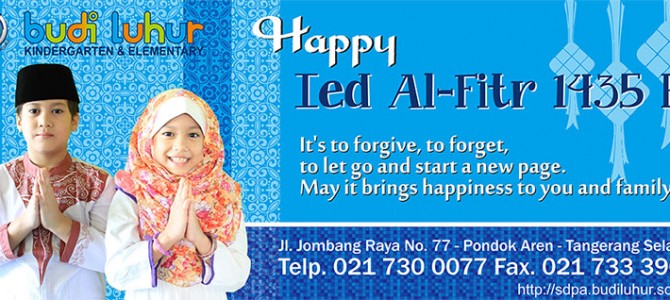Kami mengucapkan Selamat Hari Raya Idul Fitri 1435 H.
Mohon maaf Lahir dan Batin.

Kami mengucapkan Selamat Hari Raya Idul Fitri 1435 H.
Mohon maaf Lahir dan Batin.
Sunday, 2nd march 2014
Congratulation for the 1st winner of The Paper Air Plane Competition at Pluit Jakarta Utara. This competition was held for the first time in Indonesia. Budi Luhur got a chance to compete to the next level in Singapore.
The competition was really tough and challenging. Budi Luhur was the only school representing Indonesia. The other participants were mostly from Singapore and Malaysia.
They are: Mr. Shendy, Abednego, Baskoro, Kevin as they’re posing at Singapore Amazing Flying Machine at 21-22 March 2014. Well done…
Tuesday, 18th December 2013
Many Children welcomed the festive season “Christmas is coming….” The children shouted in excited anticipation.
This Christmas, we invited a preacher to come and speak to us and give advice. The event included a performance from the students and parents. The giving of gift was very exciting. All students enjoyed the event immensely.
Friday, 6th December 2013
This event was celebrated by involving parents and students. Parents were invited to come and teach at the school. They were highly excited in presenting their lessons and their contribution was much appreciated.
Some students were selected to impersonate and imitate the teachers (which was an amusing surprise for the teachers).
In appreciation of their favorite teachers students gave chocolates to them, so now waistlines will expand!
Monday, 3rd February 2014
Gong Xie Fat Coi
As we celebrated the Chinese New Year, our school invited a Barongsai (Lion Dance) to SMA Budi Luhur. Students came to watch and enjoy the colourful performance.
Lion dance (simplified Chinese: 舞狮; traditional Chinese: 舞獅; pinyin: wǔshī) is a form of traditional dance in Chinese culture and other Asian countries, in which performers mimic a lion’s movements in a lion costume. The lion dance is usually performed during theChinese New Year and other Chinese traditional, cultural and religious festivals. It may also be performed at many other important occasions such as business opening events, special celebrations or wedding ceremonies, or may be used to honour special guests by the Chinese communities.
The Chinese lion dance is often mistakenly referred to as dragon dance. An easy way to tell the difference is that a lion is normally operated by two dancers, while a dragon needs many people. Also, in a lion dance, the performers’ faces are only seen occasionally, since they are inside the lion. In a dragon dance, the performers’ faces can be easily seen since the dragon is held on poles. Basic Chinese lion dance fundamental movements can be found in most Chinese martial arts.
There are two main forms of the Chinese lion dance, the Northern Lion and the Southern Lion. Both forms are commonly found in China, but around the world especially in South East Asia the Southern Lion predominates as it was spread by the Chinese diasporacommunities who are historically mostly of Southern Chinese origin. Versions of the lion dance are also found in Japan, Korea,Vietnam, and Tibet. Another form of lion dance exists in Indonesian culture, but this is of a different tradition and may be referred to as Singa Barong. – (source: Wikipedia)